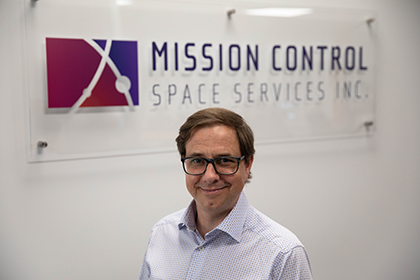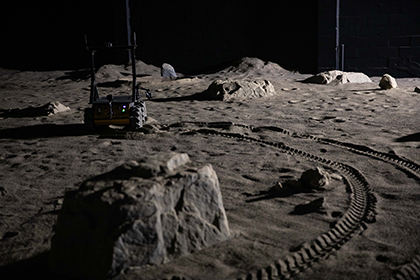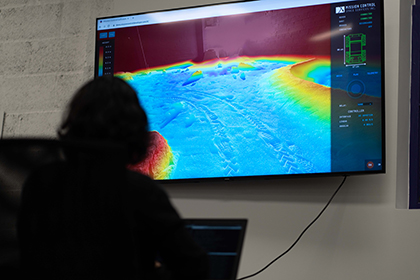Mission Control software puts Canada on the moon

When Ewan Reid passionately describes that his software is going to the moon next year, it’s hard to imagine he almost became a banker.
But an exciting opportunity at an aerospace company and landing a job as a shuttle flight controller at the Kennedy Space Center in Florida in 2008 changed his course and set him on the path to working in the aerospace industry.

Ewan Reid, founder and CEO of Mission Control based in Ottawa, Ontario, Canada.
Reid is the founder and CEO of Mission Control, an Ottawa-based space exploration and robotics company incorporated in 2015. From its humble beginnings to producing software destined for the moon, the company has reached new heights and will mark a significant milestone next year.
Mission Control teamed up with the Mohammed Bin Rashid Space Centre in Dubai, United Arab Emirates, to help a small rover navigate the moon’s terrain. Mission Control’s cutting-edge artificial intelligence software operates robots via the Internet.
Back on earth, Mission Control’s software will send data almost in real time to scientists at 4 Canadian universities who will work with the Dubai space centre team to decide where the rover should go.
This partnership with the Mohammed Bin Rashid Space Centre allows Mission Control to demonstrate their technology for the first time in space.
“This is the first Canadian software, the first Canadian computer, the first Canadian artificial intelligence to go to the moon,” said Reid. “I’m really proud of our team and honoured for us to be, in a way, representing Canada on the Emirates’ lunar mission.”

A rover drives around Mission Control’s 4,000-square-foot room that was built to look like the surface of the moon.
There’s no doubt that Mission Control is ready for its first foray into space, which could open up many opportunities for the company.
They’ve been practising with the little bit of “space” they brought to their office: a 4,000-square-foot room constructed to look like the surface of the moon, where they drive rovers using their software.
Dubbed the “moonyard” by the company, it’s a testing facility with sand, rocks, craters, black walls and lights that simulate the sun where Mission Control and partners can practise before going on real moon explorations.
Mission Control was proud to share their world-class facility and software in Dubai in 2021. Reid and several colleagues travelled to Expo 2020 Dubai and the International Astronautical Congress to share their work with a global audience.
“It’s critical in the space industry to work with international space organizations. Almost no space missions can be completed by a single country,” said Reid. “Going to something like Expo is really important for us to build those relationships, those partnerships, and ultimately execute exciting and important space missions.”

Apeksha Budkhar, a project engineer with Mission Control, uses the company’s software to drive a rover in the “moonyard.”
Canada’s Trade Commissioner Service (TCS) has helped Mission Control explore markets in Israel, Italy, Japan, Mexico and the United Arab Emirates.
During a trade mission to the United Arab Emirates in 2019, Reid met with officials from the Mohammed Bin Rashid Space Centre for the first time.
And in Japan, the TCS introduced Reid to ispace, a lunar exploration company that is crucial to the Mohammed Bin Rashid Space Centre mission. An ispace lander will carry the space centre’s rover and Mission Control’s software to the moon.
The TCS ensured Mission Control had a “soft landing” in international markets to forge new partnerships for this Ottawa start-up company and help it reach new heights.
Mission Control
Transcript
Canada truly are leaders when it comes to space, robotics, AI, the software that brings all those things together.
More and more countries and companies around the world are planning missions to space. And Canadians and, you know, engineers and scientists, we are working and happy to collaborate with these groups and help make their missions better.
Hi, I'm Ewan Reid. Welcome to Mission Control.
It's really a great opportunity to highlight the work that our company is doing with a global audience. We get some exposure in Canada and the U.S. and other places that we work. But going to Expo is the kind of thing that that sets us on the world stage. And when we're talking about doing something like going to the moon—you know, what better place than to talk about that at the Expo of the world.
So MBRSC will be sending a small rover to the surface of the moon called the Emirates Lunar Mission, and our computer will be riding along on the Japanese lander, and it will help this rover to navigate.
There are 2 types of software: software that will be in space with the rover and then software that will be here on earth, helping operators on the ground.
In the space segment, it's a machine-learning system that helps the rover look ahead and understand what kind of terrain is in front of it.
Here on the ground, we have software that will distribute the mission data to scientists—in this case, at 4 Canadian universities, and help those scientists and engineers to work with the team at MBRSC, the Mohammed Bin Rashid Space Centre in the U.A.E., decide where the rover should be navigated and where it should go.
So here at our Headquarters, Mission Control Headquarters in downtown Ottawa, we actually have an over 4,000-square foot moonyard facility, an indoor lunar analog terrain, we call it. It's a testing setup that we can use to operate robots, to take pictures and train machine-learning algorithms. Really, it's a world- class facility that ourselves and our partners can use to prepare before we go and conduct real exploration on the moon, a lot of which is going to be happening over just the next few years.
So this will actually be the first Canadian software, the first Canadian computer, the first Canadian AI to go to the moon.
- Date modified: